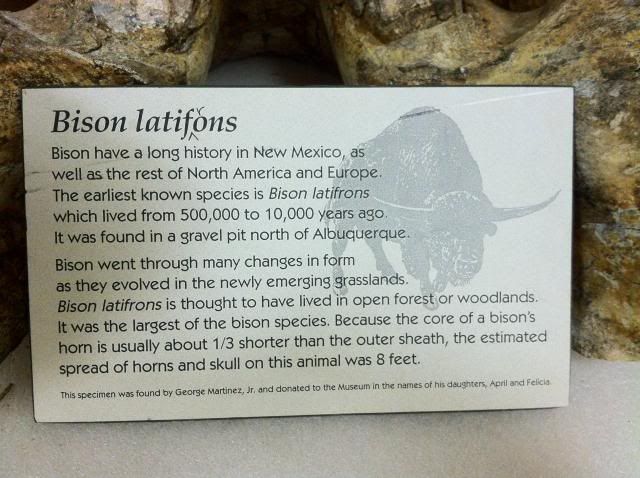Last month’s challenge was extremely hard. Once again, the bone fragments cause the most problems for the participants. However, Isotelus came the closest with:
At least in the photo it doesn’t look to be very old relatively speaking, so I’m going to guess it’s an Ice Age-ish horn core and partial skull of an ancient bovid, possibly Bison of some sort. Size is hard to assess definitively, but I’m guessing it’s not a modern Bison or B. latifrons. B. priscus or antiquus?
Isotelus was correct in that this is an Ice Age critter; it was indeed a horn core and partial skull of a Bison. Still, she did not think it was a Bison latifrons when this partial skull is indeed from B. latifrons. Nevertheless, I believe that if I used a scale in that photo, she would have come up with the correct answer.

(Taken at the New Mexico Museum of Natural History and Science)
B. latifrons lived throughout North America 500,000 to 20,000 years ago during the Pleistocene. B. latifrons is the largest species of Bison (and possibly bovid) known. An adult male was ~2.5 meters at the shoulder and weighed over 2,000 kilograms. From tip to tip (including the outer sheath that grew over the bone core), B. latifrons had horns that measured ~2.4 meters across.
B. latifrons inhabited mostly woodlands and open forests, which means it was most likely a browser, feeding off shrubs and trees, unlike modern Bison. B. latifrons most likely used its large horns defending itself from predators and fighting for territory and mates. B. latifrons is not only possibly the largest bovid, but also one of the largest artiodactyls to have ever lived (on land).
Moving on to thiqs month’s challenge:

(Taken at the New Mexico Museum of Natural History and Science)
This one should be an easy one, so easy in fact that I would like to know the name of the critter and why it is so important.